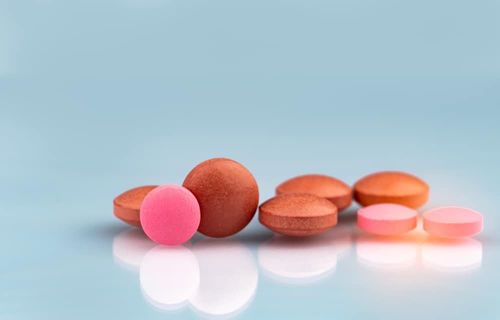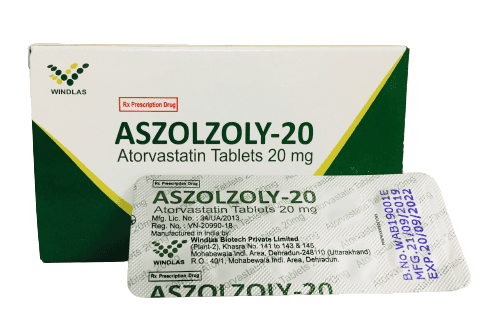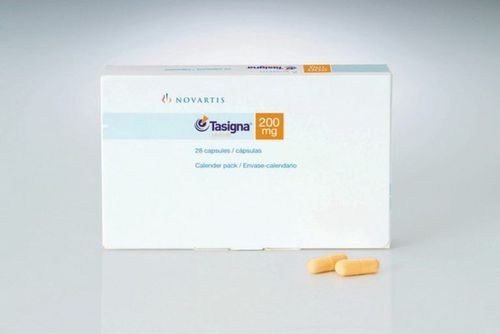This is an automatically translated article.
Prolol 5 is indicated for use mainly in conditions with hypertension, angina pectoris or stable chronic heart failure. During treatment with Prolol 5, the patient should strictly follow the dosing instructions recommended by the specialist.
1. What is Prolol 5?
Prolol 5 belongs to the group of cardiovascular drugs commonly prescribed by doctors to treat cases of angina pectoris, hypertension and stable chronic heart failure.
Prolol 5 is prepared in the form of film-coated tablets, packed in a box of 3 blisters x 10 tablets. Each Prolol 5 tablet contains the following specific pharmaceutical ingredients:
Main active ingredient: Bisoprolol fumarate 5mg. Other excipients sufficient for one tablet: Lactose monohydrate, Microcrystalline cellulose 102, Crospovidone CL, Copovidone VA 64, Polyethylene glycol 6000, Colloidal silicon dioxide, Titanium dioxide, Magnesium stearate, Hydroxypropylmethyl cellulose 606, Talc powder, Tartrazine lake and Quinoline yellow.
2. Prolol 5 uses and contraindications for use
2.1 Indications for the use of Prolol 5 Prolol 5 is often used by doctors for the following cases:
Treatment of hypertension. Treatment of angina pectoris. Treatment of stable chronic heart failure of moderate to severe severity, accompanied by reduced left systolic function. Prolol 5 can be used in combination with diuretics, ACE inhibitors and cardiac glycosides. However, this combination is only applied when prescribed by a specialist. 2.2 Contraindication to the use of Prolol 5 Do not use Prolol 5 for the following cases:
Patients with cardiogenic shock, heart failure not controlled by background treatment, acute heart failure, heart failure grade III/IV, atrioventricular block II or III. Prolol 5 is contraindicated in patients with sinus bradycardia below 60/min or with sinus node disease. Prolol 5 should not be used in patients with chronic obstructive pulmonary disease or severe asthma. Prolol 5 is contraindicated in people with hypersensitivity to the active ingredient Bisoprolol or any other ingredient in the drug. The drug should not be used in patients with severe Raynaud's syndrome. Patient has untreated pheochromocytoma (adrenal myeloma).
3. Dosage and how to use Prolol 5
3.1 Dosage of Prolol 5 The dose of Prolol 5 will be determined based on the doctor's assessment of each patient's age, health status, and drug tolerance.
Dosage for treatment of hypertension and angina pectoris The usual recommended initial dose of Prolol 5 is 2.5 to 5 mg/day. The drug should be used with caution in patients with bronchospasm because the active ingredient Bisoprolol fumarate in the drug has a beta 1 adrenergic blocking effect that decreases with increasing dose. This patient population should be initiated at a dose of 2.5mg once daily. If the 5 mg dose does not provide the desired adequate therapeutic effect, an increase to 10 mg may be considered, followed by a gradual increase to a maximum dose of 20 mg once daily.
Dosage for stable chronic heart failure Patients with stable chronic heart failure without exacerbations within 6 weeks should be treated with an ACE inhibitor (or other vasodilator) along with a diuretic. urine or Digitan before using Prolol 5 . Do not change the dose of the drug during the last 2 weeks before using Prolol 5. In addition, treatment with these drugs in patients with chronic stable heart failure should be closely monitored by a physician. specialist.
Dosage of Prolol 5 for stable chronic heart failure will be gradually increased according to the following regimen:
Take 1.25mg/time/day in the morning for 7 days. If tolerated by the patient, an increase in dose may be considered. Take 2.5mg/time/day for 7 days. If well tolerated by the patient, an increase in dose may be considered. Take 5mg/time/day for 4 weeks afterwards. Consider increasing the dose if well tolerated by the patient. Orally 7.5mg/time/day for 4 weeks thereafter, increase dose if patient well tolerated. Take 10mg/time/day to maintain stable chronic heart failure treatment. After starting the patient on the first dose of 1.25mg, the doctor will closely monitor the patient's parameters within 4 hours, especially blood pressure, conduction disturbances, heart rate and heart rate. more severe signs of heart failure.
In general, the dose adjustment will be based on the patient's tolerance to reach the target dose. Some patients during the use of Prolol 5 may experience side effects and may not be able to achieve the maximum recommended therapeutic dose. At this point, it is necessary to gradually reduce the dose for patients with stable chronic heart failure, even temporarily stopping treatment, then resuming treatment.
If drug intolerance or worsening of heart failure occurs with pulmonary edema, bradycardia, cardiogenic shock or atrioventricular block, the patient should stop treatment immediately. According to the doctor's recommendation, the treatment of stable chronic heart failure with Prolol 5 is a long-term therapy, it is necessary to avoid as much as possible stopping the drug, because this can make the heart failure worse. more important. If discontinuation is required, the patient will need to gradually reduce the dose and divide the dose in half each week.
Dosage for patients with hepatic / renal impairment The initial dose of Prolol 5 for patients with renal / hepatic impairment (creatinine clearance < 40 ml/min) is 2.5 mg/day, then the dose is gradually increased. The maximum dose for patients with clearance < 20ml/min is 10mg/day for the treatment of both hypertension and angina.
3.2 How to use Prolol 5 Prolol 5 is made in tablet form, so patients can take it orally. Before taking the drug, carefully read the instructions for use in the leaflet enclosed with the medicine box or as directed by a specialist.
During treatment with Prolol 5, patients need to take the correct dose and frequency of medication prescribed previously. Absolutely avoid arbitrarily increasing the dose or adjusting the dose according to personal purposes because this can potentially pose many other health risks.
4. Some side effects may be encountered when taking Prolol 5
Common side effects:
Dizziness, dizziness, sweating, fatigue, headache. Sleep disturbance, dreaming. Anxiety, depression or distraction. These symptoms are usually mild and do not affect the patient's health. Usually, these side effects will go away on their own within 1-2 weeks after starting treatment with Prolol 5.
5. Things to keep in mind when taking Prolol 5
5.1 What precautions should be taken while using Prolol 5? The following are precautions to be taken during treatment with Prolol 5:
Patients with signs of congestive heart failure should avoid beta blockers. However, in cases where it must be used in certain patients with compensatory heart failure, the drug should be used with great caution. Abrupt discontinuation of Prolol 5 may worsen angina, ventricular arrhythmias, or myocardial infarction in people with coronary artery disease. Therefore, patients need to consult their doctor before deciding to stop taking the drug. Because Prolol 5 is relatively beta-selective, patients with bronchospasm who are intolerant or unresponsive to other antihypertensive therapy should be treated with extreme caution. For patients preparing for surgery, it is necessary to temporarily stop taking Prolol 5 at least 48 hours before surgery. In cases where medication is required during surgery, the patient should be cautious with anesthetic agents such as Trichlorethylene, Cyclopropane and Ether. If an overdose occurs, it can be treated by administering atropine from 1 to 2 mg IV. Prolol 5 may mask the symptoms of hypoglycemia, typically tachycardia. For patients with diabetes treated with oral hypoglycemic agents or insulin, Prolol 5 should be used with caution. Prolol 5 may also mask clinical manifestations of hyperthyroidism, such as tachycardia. The sudden use of the drug can trigger a dangerous attack of thyrotoxicosis. 5.2 Interactions of Prolol 5 with other drugs The following is a list of drugs that can interact with Prolol 5 when taken together:
Other beta-blockers. Catecholamine-depleting drugs, including Clonidine, Alpha-methyldopa, Reserpine, and Guanethidine. Drugs that relax the myocardium or inhibit atrioventricular conduction, such as calcium antagonists, benzothiazepines, antiarrhythmics. Rifampin drug. Insulin and some oral hypoglycemic drugs. Hopefully, with the important information about Prolol 5 drug, it helps patients understand the effects, dosage and how to use the drug so that it is safe and secure.
Please dial HOTLINE for more information or register for an appointment HERE. Download MyVinmec app to make appointments faster and to manage your bookings easily.













